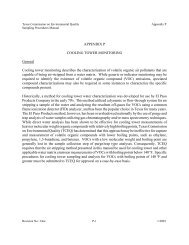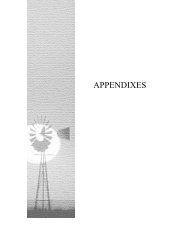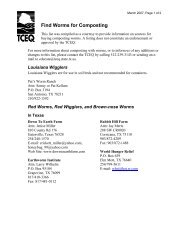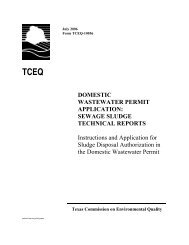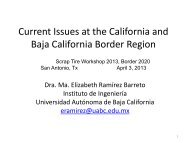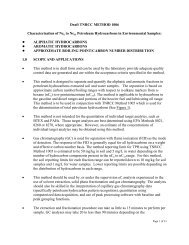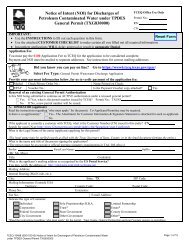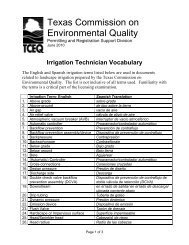Brazos River and Associated Bay and Estuary System Basin and ...
Brazos River and Associated Bay and Estuary System Basin and ...
Brazos River and Associated Bay and Estuary System Basin and ...
Create successful ePaper yourself
Turn your PDF publications into a flip-book with our unique Google optimized e-Paper software.
<strong>Brazos</strong> <strong>River</strong> <strong>and</strong> <strong>Associated</strong> <strong>Bay</strong> <strong>and</strong> <strong>Estuary</strong> <strong>System</strong><br />
<strong>Basin</strong> <strong>and</strong> <strong>Bay</strong> Stakeholder Committee (BBASC) Meeting<br />
Tuesday, July 17, 2012 at 10:00 a.m.<br />
<strong>Brazos</strong> <strong>River</strong> Authority Offices<br />
Waco, Texas<br />
Minutes<br />
Call to 0rder<br />
BBASC chair Dale Spurgin called the meeting to order. BBASC members introduced themselves.<br />
Review of agenda & meeting goals<br />
Facilitator Suzanne Schwartz reviewed the meeting agenda <strong>and</strong> goals with the BBASC. No agenda<br />
modifications were suggested.<br />
Public comment<br />
Chris Wingert with West Central Texas Municipal Water District reiterated five points in his<br />
comments to the BBASC. His comments are posted to the BBASC web page at:<br />
http://www.tceq.texas.gov/permitting/water_rights/eflows/brazos-river-<strong>and</strong>-associated-bay-<strong>and</strong>estuary-system-stakeholder-committee-<strong>and</strong>-expert-science-team.<br />
Approval of June 27-28, 2012 meeting minutes<br />
BBASC members approved the June 27-28, 2012 meeting minutes without changes.<br />
Subcommittee updates<br />
Funding/facilitation<br />
Dale Spurgin reviewed an updated finance report detailing the contributions to <strong>and</strong> payments<br />
from the BBASC funds account administered by the fiscal agent, West Central Texas Council of<br />
Governments (WCTCOG).<br />
Report writing<br />
Subcommittee chairman Tom Conry asked that all BBASC members submit their personal<br />
testimonies of their experiences with the river. And since the City of Waco will be hosting the next<br />
set of meetings (July 30-31), Tom invited all to see examples of old <strong>and</strong> cutting edge water<br />
treatment technologies at the City’s facilities. A majority of the group indicated that setting up a<br />
tour prior to the first day’s meeting would work best.<br />
Technical analysis<br />
Presentations on technical analyses followed the subcommittee reports.<br />
Strategies<br />
Attention was directed to a Strategies Development memo (h<strong>and</strong>out) provided by subcommittee<br />
member Matt Phillips. A detailed discussion of strategies is planned for the July 30 th meeting.<br />
Suzanne reminded BBASC members to provide any strategies-related information that they’re<br />
aware of to the subcommittee.<br />
Technical reports, including: (1) project yields under possible environmental flow<br />
st<strong>and</strong>ards; <strong>and</strong> (2) biological impact of changing pulse flows<br />
Kevin Mayes from TPWD coordinated with Dr. Wilde from Texas Tech University, at the request of<br />
the BBASC, to determine the impact on the smalleye shiner of reduced magnitude <strong>and</strong> frequency of<br />
high flow pulses based on the Cedar Ridge Reservoir template using HDR’s WAM/FRAT output for<br />
the Double Mountain West Reservoir simulation at the Double Mountain Fork at Aspermont gage.<br />
Kevin presented his analysis (PowerPoint slides available on the BBASC webpage:
http://www.tceq.texas.gov/permitting/water_rights/eflows/brazos-river-<strong>and</strong>-associated-bay-<strong>and</strong>estuary-system-stakeholder-committee-<strong>and</strong>-expert-science-team).<br />
The following are responses to<br />
the questions <strong>and</strong> answer session or represent discussion that followed:<br />
• In the slides, the “no-eflow” scenario assumes no required releases from the reservoir for<br />
environmental flows, but with water rights releases. It is shown for comparison purposes.<br />
• The minimum length of river for health of the smalleye shiner population is not known at this<br />
time.<br />
• Mean summer discharge = daily flow from May to September (base flows + high flow pulses).<br />
It is, essentially, any discharge registered at the <strong>Brazos</strong> <strong>River</strong> at Seymour streamflow gage.<br />
• Q: Will the species survive the low base flow periods?<br />
A: The smalleye shiner needs pulse flows. They spawn when there is flow. Spawning peaks<br />
during pulses. Cindy Loeffler, TPWD, added that base flows without pulse flows over<br />
extended time would create problems.<br />
• The Wilde study shows the threshold requirement is 227 cfs for the <strong>Brazos</strong> <strong>River</strong> at Seymour.<br />
If the mean summer discharge is greater than 227 cfs, the species population increases; if it is<br />
less, the population decreases.<br />
• An EFS to meet the 227 cfs could be calculated.<br />
• The smalleye shiner was chosen because it is endemic to the <strong>Brazos</strong> <strong>River</strong>, is a broadcast<br />
spawning minnow with a requirement for flow to reproduce, <strong>and</strong> is a c<strong>and</strong>idate for listing<br />
under the Endangered Species Act with U.S. Fish <strong>and</strong> Wildlife Service gathering data on it.<br />
Cory Shockley of HDR Engineering, at the request of the BBASC, provided information on<br />
impacts to the yield of the Double Mountain Fork <strong>and</strong> Little <strong>River</strong> Reservoir (on-channel) if<br />
additional pulse flows were required above those in the Cedar Ridge Reservoir (CRR) template,<br />
which the BBASC adopted for gages 4, 5 <strong>and</strong> 6 at its June 28 meeting. (Power point slides<br />
available on the BBASC website). The following are responses to the questions <strong>and</strong> answer<br />
session or represent discussion that followed:<br />
• The calculation is based on a year <strong>and</strong> not just a summer.<br />
• Q: What is the spawning cue flows for the <strong>Brazos</strong>?<br />
A: (Kevin Mayes) It is site specific <strong>and</strong> depends on the species present. Smalleye shiners do<br />
asynchronous spawning when the river is flowing; this level of spawning does not build up the<br />
population. Pulses cause synchronous spawning: a significant increase in numbers. This is<br />
because the eggs float <strong>and</strong> need flows for dispersal. The smalleye shiner can spawn many<br />
times each season, depending on flow <strong>and</strong> whether eggs remain.<br />
• Kirk Winemiller of the <strong>Brazos</strong> BBEST, told the BBASC that the information provided by Kevin<br />
Mayes <strong>and</strong> Cory Shockley was important <strong>and</strong> what they need to consider risk management to<br />
both the species <strong>and</strong> water supply. He noted the following related to biology:<br />
o Transport is important, but so is turbidity, which enhances survival of early life stages.<br />
Both are aided by pulses.<br />
o The BBEST focused on these fluvial species because they are the most sensitive. But<br />
high flow pulses are important for other things like geomorphology, which assure the<br />
channel is adequate for the species also.<br />
o The BBEST environmental flow regime already represents a reduction of flows from the<br />
status quo. This is further compounded because the flow regime will not be reproduced<br />
as it is shown. It was designed with multiple tiers to protect biodiversity.<br />
• Kevin Mayes noted that there is a difference between Clear Fork species <strong>and</strong> species that live in<br />
the upper <strong>Brazos</strong>. They have different reproductive strategies <strong>and</strong> thus the spawning cues,<br />
timing <strong>and</strong> habitat needs may be very different. He also noted that the CRR template reduces<br />
the geomorphological functions of high flows. He also gave his opinion that eliminating pulses<br />
is a high risk to the species.<br />
• Cory Shockley noted that the high flows are important to reservoir yield. At HFP 1 <strong>and</strong> 2, the<br />
reductions in yield are great from including additional pulses to the CRR template, but the<br />
increases in flow are small. Also, only one acre-foot out of four makes it from the Double
Mountain Fork site downstream (to Possum Kingdom <strong>and</strong>, especially pronounced by Lake<br />
Waco).<br />
• Q: what does the CRR template do to the passage of pulses over time?<br />
A: (Cory) The reservoir will meet other HFP much of the time with the CRR template, but<br />
those would not be “protected.” The drought of record is where the greatest impact is. Adding<br />
additional pulse flows increases the time the reservoir takes to refill, essentially prolonging the<br />
drought of record.<br />
• Q: Would the drought kill the smalleye shiner?<br />
A: (Kevin) In nature, the shiner would follow water downstream. Reservoirs would stop that<br />
movement. The shiner do not do well in the reservoir, <strong>and</strong> is more subject to predators. We<br />
don’t yet know the effectiveness of the TPWD’s attempts to relocate the <strong>Brazos</strong> <strong>River</strong> shiners<br />
downstream of Waco.<br />
• Q: What is the benefit of releasing water in a year like 2011?<br />
A: (Kevin) We haven’t looked at specific possibilities using different flow levels. But the data<br />
provided in the power point provides parameters that can be considered.<br />
• Q: What kind of change is acceptable?<br />
A: (Kevin) Minnows are used because data was available <strong>and</strong> they are sensitive. A 1-2-1 CRR<br />
template at Aspermont creates a very high risk to the minnows.<br />
• Kirk Winemiller said to underst<strong>and</strong> more about their response would require a modeling effort<br />
of three to five years, <strong>and</strong> $300,000 to $500,000.<br />
Develop environmental flow st<strong>and</strong>ard components: base <strong>and</strong> pulse flows; hydrologic<br />
triggers<br />
General discussion: BBASC members discussed the balancing process it is statutorily charged to<br />
accomplish.<br />
• Our recommendations could kill a project, <strong>and</strong> we’re using a blunt instrument to make our<br />
decisions. Projects will require a rigorous review before being built.<br />
• Kathy Alex<strong>and</strong>er noted the following in response to questions:<br />
o Once TCEQ adopts environmental flow st<strong>and</strong>ards, it will evaluate new projects to see if<br />
there is unappropriated water available for the project after satisfying the EFS. Then,<br />
TCEQ would include environmental conditions in the permit to protect the EFS.<br />
o When TCEQ is developing <strong>and</strong> adopting EFS rules, it will consider the BBASC, BBEST,<br />
public comments etc.<br />
o TCEQ will evaluate whether the BBASC recommendation maintains the possibility of<br />
future permits.<br />
• Need to reflect challenges of different parts of the basin<br />
• Differing views were expressed about the impacts of setting EFS high or low given the potential<br />
to use adaptive management <strong>and</strong> thus change EFS rules in the future. Kathy Alex<strong>and</strong>er<br />
explained that once TCEQ adopts EFS rules, those st<strong>and</strong>ards are imposed on all future<br />
permits, unless the EFS rules are changed. BBASC members expressed the following:<br />
o It will be difficult to make EFS less stringent once they are adopted.<br />
o If st<strong>and</strong>ards are set too low now, water will be appropriated, effectively preventing the<br />
water from being used for the environment in the future or for more stringent EFS to<br />
be adopted.<br />
o There is not much water available in the basin without a storage project.<br />
o The special conditions imposed in a water right permit based on EFS can be relaxed<br />
(lowered) in an unlimited amount, but can be adjusted in a more stringent manner only<br />
by 12.5%<br />
• BBASC members discussed what projects the regional water plans identify as needed.<br />
Regional water plans identify three categories of strategies to meet water needs:<br />
recommended, alternative, <strong>and</strong> evaluated. For the <strong>Brazos</strong>, recommended projects include<br />
Cedar Ridge, Turkey Peak, Lake 07 (Lubbock), Millers Creek Augmentation, Post. (The<br />
BBASC determined later in the meeting to ask TWDB for a list of projects that are<br />
recommended <strong>and</strong> alternative, including yield <strong>and</strong> cost.)
o The process to design <strong>and</strong> permit these projects starts 20 to 25 years ahead of their<br />
completion.<br />
Implementation rule; hydrologic trigger.<br />
The facilitator asked the BBASC to clarify the extent of its decisions from the June 28 meeting relating<br />
to the use of the implementation rule <strong>and</strong> the hydrologic trigger.<br />
Consensus<br />
The BBASC reviewed its decisions at the last meeting <strong>and</strong> confirmed as follows:<br />
The BBASC reviewed its decisions from the last meeting <strong>and</strong> confirmed as follows:<br />
• For gages 4 (Clear Fork <strong>Brazos</strong> near Nugent), 5 (Clear Fork <strong>Brazos</strong> near Fort Griffin) <strong>and</strong> 6<br />
(<strong>Brazos</strong> <strong>River</strong> near South Bend): In adopting the BBEST base flows on June 28, the BBASC<br />
also intended to adopt the BBEST 50% implementation rule (associated with diversions<br />
between the dry base flow st<strong>and</strong>ard <strong>and</strong> subsistence flow)<br />
• For all gages: For the hydrologic trigger to determine if the base <strong>and</strong> pulse flows must meet<br />
dry, average or wet st<strong>and</strong>ards, the BBASC determined to use the Palmer Hydrologic Drought<br />
Index (PHDI) <strong>and</strong> to divide the basin into three areas for such application: above Possum<br />
Kingdom Reservoir dam, below Possum Kingdom Reservoir dam but above Lake Whitney<br />
dam, <strong>and</strong> below the Lake Whitney dam.<br />
Consideration of EFS for gages 1 (Double Mountain Fork near Aspermont), 2 (Salt Fork <strong>Brazos</strong> near<br />
Aspermont) <strong>and</strong> 3 (<strong>Brazos</strong> <strong>River</strong> near Seymour).<br />
Before considering specific EFS for gages 1, 2 <strong>and</strong> 3, BBASC members discussed some of their needs<br />
<strong>and</strong> interests in developing the EFS recommendations, by responding to the following question:<br />
“The EFS for gages 1-3 need to be designed in a way that…” (responses from BBASC follow):<br />
• Considers other uses for water<br />
• Flexibility for e-flows in the future, allows for adaptive management<br />
• Doesn’t eliminate endangered species<br />
• Maintains a healthy system<br />
• Doesn’t preclude development of new water sources, reservoirs<br />
• Recognizes the flashy nature of the gages in the area <strong>and</strong> that the area is different than in the<br />
lower basin<br />
The BBASC members then brainstormed some ideas to meet these needs:<br />
• Pray for rain<br />
• Build an ark<br />
• Require environmental flow releases from stored water<br />
• Adaptive management programs to preserve species in dry periods:<br />
o Habitat creation<br />
o Recirculate water<br />
o Create refuge in reservoirs<br />
• Legislature funds the state water plan<br />
• Watermaster<br />
• Flow from other sources<br />
o Wastewater treatment plant<br />
o Brush control (e.g. to eradicate salt cedar)<br />
Consensus<br />
The BBASC affirmed its decisions on gages 1 (Dbl Mtn Fork near Aspermont), 2(Salt Fork near<br />
Aspermont) <strong>and</strong> 3 (<strong>Brazos</strong> at Seymour) from May 27-28 to adopt the BBEST recommendations for<br />
base flow, including the 50% implementation rule, for gages 1, 2 <strong>and</strong> 3.
BBASC members generated ideas for h<strong>and</strong>ling pulse flows for gages 1, 2 <strong>and</strong> 3:<br />
• Simplify flows at gages <strong>and</strong> voice specific concerns in the narrative submitted to TCEQ<br />
• Use the 1-2-1 Cedar Ridge Reservoir template<br />
• Revisit in work plan<br />
• Consider EFS for specific projects without species impact separately<br />
• Provide a narrative about competing needs <strong>and</strong> species<br />
• Adopt the Cedar Ridge Reservoir template but with increased pulse frequencies<br />
• Provide winter pulses<br />
• Adopt one of the alternate CRR template pulse flow scenarios (from Cory’s presentation):<br />
o 3-4-3<br />
o 2-3-2<br />
o 2-2-1<br />
• Adopt BBEST <strong>and</strong> revisit via adaptive management <strong>and</strong> include language to allow projects to<br />
move forward<br />
• Could move some if I know something is being done to protect species<br />
• Use the Cedar Ridge 1-2-1 template, modified by using the high pulse flow 3&4 in the winter<br />
o Concern about channel morphology function of the higher pulse flows<br />
o But they will occur anyway<br />
• Adopt the Cedar Ridge (1-2-1) st<strong>and</strong>ard for all of gages 1 through 6. But add caveat to the EFS<br />
recommendation that any reservoir to be built above these gages should show they would not<br />
impact the shiner<br />
Brad Brunett noted that the evaluations the technical work group conducted, <strong>and</strong> those that Cory<br />
Shockley conducted also, shows that throughout the basin, the yield of on channel reservoirs would be<br />
impacted by ± 40%,but there would be little impact to the yield of off-channel reservoirs. Kathy<br />
Alex<strong>and</strong>er noted that in determining whether an off channel reservoir could be permitted, <strong>and</strong> the<br />
effects of the st<strong>and</strong>ards on a future off-channel project, TCEQ staff look at how much water is<br />
available for diversion from the river.<br />
The BBBASC began to consider the structure of an EFS at gage 11, Leon <strong>River</strong> near Gatesville. The<br />
following notes reflect concerns or considerations in developing the EFS:<br />
• The Cedar Ridge Reservoir template (1-2-1) is not scientifically justified<br />
• Yield reduction if the BBEST template is used<br />
• Will TCEQ accept the BBEST template?<br />
It does not appear probable that an on-channel reservoir on the main stem of the <strong>Brazos</strong> would be<br />
built.<br />
Wrap up<br />
Next Meetings:<br />
July 30 & 31 City of Waco’s <strong>River</strong>side Water Treatment Plant located at 200 Colcord Avenue in Waco,<br />
Texas.<br />
• July 30 Morning tour of City of Waco facilities<br />
• July 30 1 p.m. BBASC meeting, focus on report <strong>and</strong> strategies<br />
• July 31 8 a.m. BBASC meeting, focus on environmental flow st<strong>and</strong>ards<br />
August 15-16 BRA headquarters<br />
August 28 BRA headquarters
Action items<br />
What Who<br />
Population dynamics model of shiner species at Seymour<br />
under BBEST/FRAT for gages 1 <strong>and</strong> 3<br />
Kevin Mayes coordinates<br />
List of Regional Water Plan projects for <strong>Brazos</strong> <strong>Basin</strong>, by Suzanne coordinate with<br />
category.<br />
TWDB<br />
Yield impact of DMF <strong>and</strong> Little <strong>River</strong> on channel with Cindy Loeffler coordinate with<br />
overbank flows removed<br />
HDR<br />
Public Comment<br />
Kirk Winemiller of the BBEST encouraged BBASC members in their deliberations to consider what’s<br />
best for the basin, <strong>and</strong> not what TCEQ might do in the rulemaking process.<br />
Adjourn




